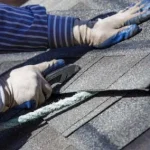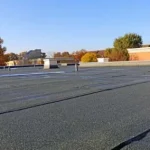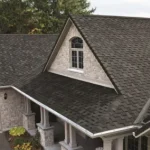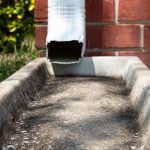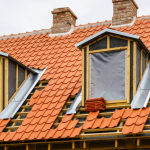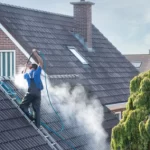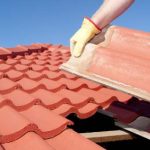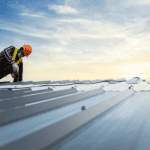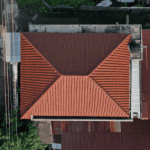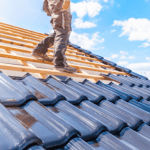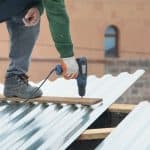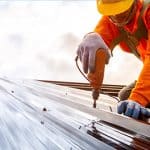
Classic roofs have been the go-to partner for ages for most homeowners. But in recent years, a new contender has emerged: the flat roof. Are you attracted to the clean and minimalistic style of a flat roof but aren’t sure if that would be a perfect fit for your home or not?
Read this blog to explore creative ideas. Learn about flat roofs, their pros and cons, and climatic conditions that fit well with this modern roofing style. Today, we’ll explore the current roofing trend. Whether you are an architect or a homeowner who is looking for an attractive roofing trend, we have got you all the solutions that are required to make an informed decision. Discover the world of roofing and the characteristics of modern flat roofs. Let’s unveil the limit to the sky with trending flat roof elegance.
What Is A Flat Roof?
Flat roofs are sloped and not completely flat. They have a much lower roof than the traditional pitched roofs. Earlier in times, flat roofs were a traditional feature of the roof, with their origins in Persian and Egyptian culture. They are most commonly found for their modern and sophisticated look in the buildings. With its waterproof membrane, it provides a seamless finish. There are a variety of materials that are used in the creation of flat roofs, such as modified bitumen, EPDM (ethylene propylene diene terpolymer), TPO (thermoplastic polyolefin), PVC (polyvinyl chloride), or the built-up roofing material like tar and gravel.
Best Climate for Flat Roofs
Although flat roof performance depends on weather changes and the region where it is installed, flat roofs are not an ideal option. They could pose challenges in certain weather conditions. Let’s explore the best climates where they perform at their fullest.
• Dry and Arid Climates
It’s the best fit for the region where rainfall is minimal, and the water damage risk is at the lowest. Areas like these could help with rainwater drainage efficiently. Moreover, the sunlight in arid regions supports the lifespan of the roofing.
• Urban and Contemporary Settings
They are mostly chosen in the urban and contemporary environment that complements the minimalist structures. Flat roofs are flexible to be combined with rooftop gardens, solar panels, or outdoor living spaces, making them a versatile choice.
• Commercial and Industrial Buildings
Flat roofs are always the number one choice for homeowners who are seeking a cost-effective and sustainable option for housing HVAC equipment, solar panels, or rooftop amenities. Their flat roof offers a valuable space utilization option.

What Are the Different Types of Flat Roofs?
Flat roofs come in a wide variety, each with unique features and advantages. The choice depends on various factors such as climate, budget, intended use, and aesthetic preference. Let’s discover some common types:
• Built-Up Roofing (BUR)
This roofing consists of multiple layers to keep the surface protected. Built-up roofs are also known as tar or gravel roofs, the number one preference for flat roofs, with alternate layers of bitumen (asphalt or coal tar) on top, in which gravel is placed to protect the surface from the different weather conditions. BUR offers waterproofing and UV protection. It’s one of the most reliable and durable options but requires regular maintenance.
• EPDM Roofing
This synthetic rubber roofing is added to the roof surface to protect it from the weather conditions. EPDM (ethylene propylene diene terpolymer) is a rubber roofing membrane. It’s known for its excellent resistance to UV rays, durability, and flexibility, making it an ideal choice. They come in sheets and are installed together to reduce the risk of leaks.
• TPO Roofing
TPO roofing is known for its energy efficiency and reflective property with its single-layer protection. They are easy to install and lightweight, which is why they are not very expensive. They are commonly found in industrial and commercial applications.
• PVC Roofing
PVC serves as a single-ply membrane for flat roofs. It offers extensive protection from chemicals, fire, and UV radiation. They are highly recommended if you are looking for a low-maintenance and durable solution. With reflective properties, it reduces energy consumption.
• Modified Bitumen Roofing
With advancement, modified asphalt roofs evolved from the traditional BUR roofs. Asphalt is a mixture of modifiers such as SBS (styrene-butadiene-styrene) and APP (atactic polypropylene) to increase flexibility and durability. Modified roofs bring plenty of benefits, such as ease of installation, resistance to temperature fluctuation, and much more. They come in sheets or rolls to cover the roofs well and prevent leakage from occurring.
• Green Roofs
Green roofs are also known as living roofs or eco-roofs. They are a sustainable option for flat roofs. Their layers of vegetation, soil, and drainage system offer insulation and absorb water efficiently. Green roofs serve the environment with a variety of benefits, such as improved insulation, more absorption of storm water, and enhanced aesthetics. They are suitable for some climates and require maintenance and special design.

Pros and Cons of Flat Roofs
Every element has various advantages and disadvantages. By understanding these, an informed decision could be made about whether a flat roof is the right option for you or not.
Pros of Flat Roofs:
- Aesthetic Appeal:
They offer an appealing appearance and enhance the beauty of your residence. - Space Utilization:
Flat Roofs can be installed on solar panels, rooftops, and outdoor living spaces. - Accessibility:
They can easily be accessed for installation, repairs, and maintenance of amenities. - Energy Efficiency:
They save on energy bills and minimize heat absorption. - Cost-Effective:
As compared to pitched roofs, flat roofs are more cost-effective, especially for industrial buildings.
Cons of Flat Roofs
- Drainage Issues:
Flat roof requires an efficient drainage system to move it away from the structure, keeping it safe. - Maintenance:
They require regular maintenance to keep their performance going. - Weather Sensitivity:
Flat roofs are not suitable for areas that are under heavy rainfall or snow. - Lifespan:
The lifespan depends on the type of material used in the manufacturing of the flat roof. Some may need replacement sooner than pitched roofs. - Limited Insulation:
Flat roof’s limited capacity can impact energy efficiency.
How Long Do Flat Roofs Last?
The reliability of the flat roof depends on some factors, such as climatic changes, maintenance, installation quality, and the type of material chosen to protect the roof. Here is an average overview of the lifespan for flat roofing materials:
- Built-Up Roofing (BUR):
With proper maintenance, it’s a relief for around 20-30 years. - EPDM Roofing:
They are durable and lasts for up to 25 to 30 years. - TPO Roofing:
TPO serves for around 20 to 30 years. - PVC Roofing:
They are considered enduring for 20 to 30 years. - Modified Bitumen Roofing:
This modern roofing lasts around 20 to 30 years and more. - Green Roofs:
Green roofs last for 30 years or more with proper maintenance.
Note: For a lasting service of any roofing, it’s essential to engage in regular maintenance to maximize its potential for a flat roof. With expert maintenance, your thousands could be saved from earlier issues.
Rise Above the Norm and Embrace Modern Living
Do you think of repairing your house, or willing to analyze its needs? Traditional Roofing styles and designs have modified the way of living. It’s one of the most preferred mediums for homeowners, and it brings reliability and durability to the house.
Explore our guide to understand the basics of it. Whether you are looking forward to gaining a solution as a homeowner or a business partner, we have got you covered with cost-effective solutions. We excel in dry and arid climate and offer contemporary roofing solutions. By understanding the pros and cons, we triple t roofing maintenance specialist ensure a smooth performance with regular maintenance and installation. We enable you to make the informed decision with our comprehensive guide. Now raise the bar of innovation and embrace the modern lifestyle with us.
Read further about flat roof replacement vs repair or why you shouldn’t install shingles on a flat roof or low slope roof for a better insight on modern aesthetics of a flat roof.





